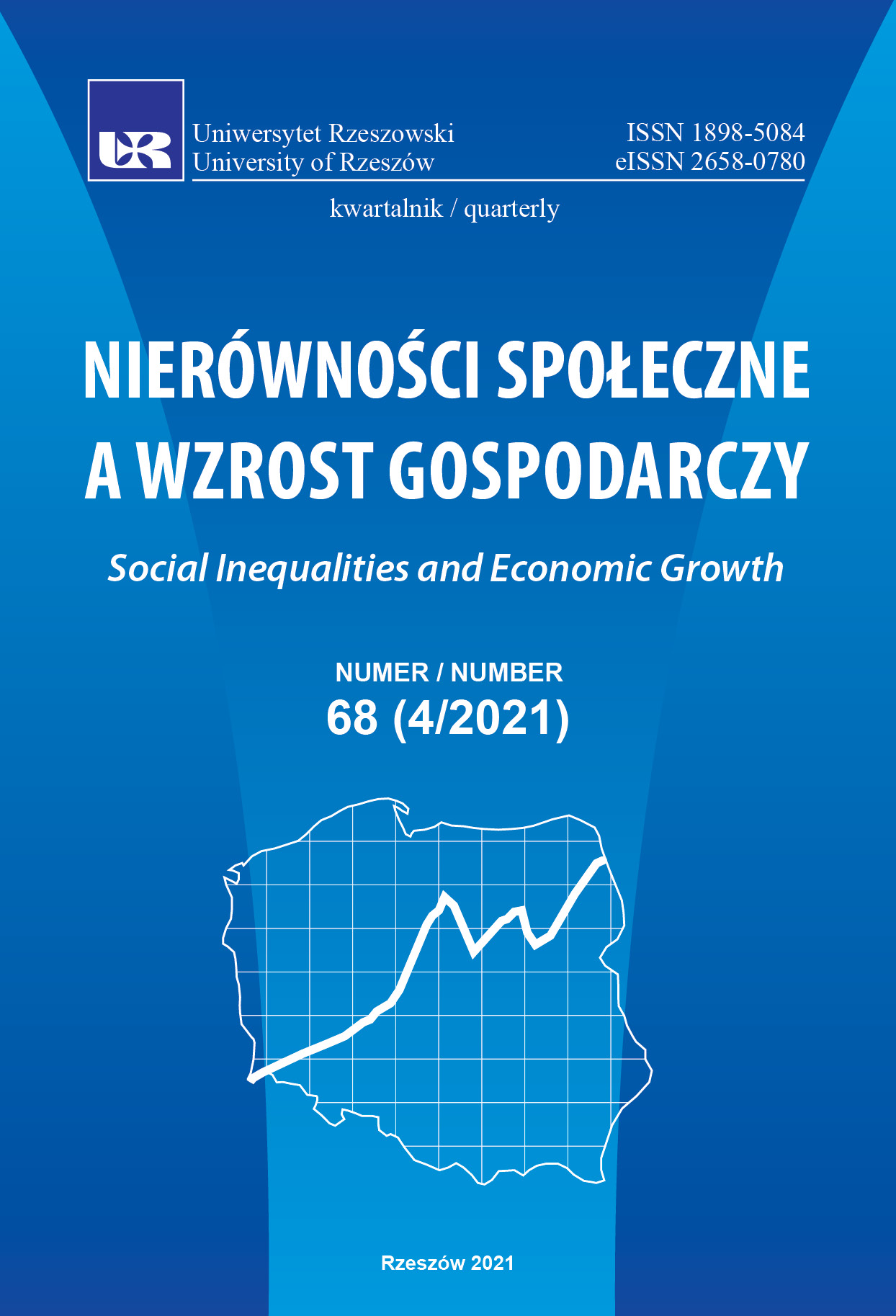Full employment – an abandoned idea and its renaissance
DOI:
https://doi.org/10.15584/nsawg.2021.4.1Keywords:
full employment, job guarantee, functional finance, stabilization of prices, ungrowthAbstract
This article deals with the recovery of the idea of full employment. Its principal aim is to gather evidence that this idea has new functions in the present social context and that the main problems of the full employment policy have reasonably well founded solutions. The method of this text is to analyse the social meaning of economic theories. In every analysis of full employment, the politics of inflation pressure seems to be the main and unresolved problem. This pressure is biggest as the economy nears full employment. The first proponents of full employment policies, including W. H. Beveridge and A. P. Lerner, knew this problem very well. Contemporary followers of full employment policies also endorse the Lernerian concept of functional finance. However, they recommend an institutional change and reject the Keynesian discretionary macroeconomic policy. Their proposition is the Job Guarantee Programme: employing all of the willing people without a job in the public sector and paying them a universal decent wage. The job guarantee is an old idea in a new form and a new context. In times of economic decline, a Job Guarantee Programme delivers a more egalitarian organisation of society and a greater level of equality instead of doubtful prospects for economic growth.
Downloads
References
Beveridge, W. H. (1909). Unemployment: A Problem of Industry. London: Longmans, Green and Co.
Beveridge, W. H. (1944). Full Employment in Free Society. London: George Allen & Unwin.
Cohen, D. (2016). W niewoli wzrostu, przeł. L. Lewin. GAB Media.
Colander, D. (1984). Was Keynes Keynesian or Lernerian? Journal of Economic Litera ture, 22(4), 1572–1575.
Forstater, M. (1999). Functional Finance and Full Employment: Lessons from Lerner for Today. Journal of Economic Issues, 33(2), 475–482. DOI:10.1080/00213624.1999.11506180.
Graeber, D. (2020). Praca bez sensu: teoria, przeł. M. Denderski. Warszawa: Wydawnic two Krytyki Politycznej.
Gray, J. (2001). Program dla zielonych konserwatystów. W: J. Gray (red.), Po liberalizmie. Eseje wybrane, przeł. P. Maciejko, P. Rymarczyk (s. 145–255). Warszawa: Aletheia.
Grzybek, D., Lendzion, M. (2017). The state as employer of last resort: the idea and selected applications. W: B. Jałocha, R. Lenart-Gansiniec, E. Bogacz-Wojtanowska, G. Prawelska-Skrzypek (red.), The Complex Identity of Public Management: Aims, Attitudes, Approaches (s. 105–117). Kraków: Instytut Spraw Publicznych UJ.
Harris, J. (1977). William Beveridge. A Biography. Oxford: Clarendon Press.
Harris, J. (1984). Unemployment and Politics. A Study in English Social Policy 1886–1914. Oxford: Clarendon Press.
Hickel, J. (2021). Mniej znaczy lepiej. O tym jak odejście od wzrostu gospodarczego ocali świat, przeł. J. P. Listwan. Kraków: Karakter.
Kalecki, M. (1979). Polityczne aspekty pełnego zatrudnienia. W: M. Kalecki (red.), Dzieła, t. 1, Kapitalizm. Koniunktura i zatrudnienie (s. 339–349). Warszawa: Państwowe Wydawnictwo Ekonomiczne.
Keynes, J. M. (2003). Ogólna teoria zatrudnienia, procentu i pieniądza, przeł. M. Kalecki, S. Rączkowski. Warszawa: Wydawnictwo Naukowe PWN.
Laidler, D. (1999). Fabricating the Keynesian Revolution. Studies of the Inter-war Literature on Money, The Cycle, and Unemployment. Cambridge: Cambridge University Press.
Lerner, A. P. (1943). Functional Finance and Federal Debt. Social Research, 10(1), 38–51.
Lerner, A. P. (1944). Economics of Control. Principles of Welfare Economics. New York: Macmillan.
Lerner, A. P. (1947). Money as Creature of the State. American Economic Review, 37(2), 312–317.
Lerner, A. P. (1951). Economics of Employment. New York: McGraw-Hill.
Milward, A. S. (1977). War, Economy and Society 1939–1945. London: Allen Lane.
Minsky, H. (2008). Stabilizing an Unstable Economy. New York: McGraw-Hill.
Mishan, E. J. (1986). Spór o wzrost gospodarczy, przeł. Z. Wolińska. Warszawa: Państwowy Instytut Wydawniczy.
Mitchell, W. F. (1998). The Buffer Stock Employment Model and the NAIRU: The Path to Full Employment. Journal of Economic Issues, 32(2), 547–555. DOI: 10.1080/00213624.1998.11506063.
Mitchell, W. F., Muysken J. (2008). Full Employment Abandoned. Shifting Sands and Policy Failure. Chelteham: Edward Elgar.
Moffit, R. A. (2003). The Negative Income Tax and the Evolution of U.S. Welfare Policy. Journal of Economic Perspectives, 17(3), 119–140. DOI: 10.1257/089533003769204380.
Mosler, W. (1997–1998). Full Employment and Price Stability. Journal of Post Keynesian Economics, 20(2), 167–182. DOI: 10.1080/01603477.1997.11490146.
Murray, M., Forstater, J. M. (red.). (2013). The Job Guarantee. Toward True Full Employment. New York: Palgrave Macmillan.
Pasinetti, L. L. (2009). Keynes and the Cambridge Keynesians. A ‘Revolution in Economics’ to be Accomplished. Cambridge: Cambridge University Press.
Phelps, E. (1995). The Origins and further development of natural rate of unemployment. W: R. Cross (red.), The Natural Rate of Unemployment. Reflections on 25 Years of the Hypothesis (s. 15–31). Cambridge: Cambridge University Press.
Phillips, A. W. (1958). The Relation Between Unemployment and the Rate of Change of Money Wage Rates in the United Kingdom, 1861–1957. Economica, 25(100), 28–299.
Szlinder, M. (2018). Bezwarunkowy dochód podstawowy. Rewolucyjna reforma społeczeństwa XXI wieku. Warszawa: Wydawnictwo Naukowe PWN.
Tcherneva, P. R. (2012). Permanent On-The-Spot Job Creation – The Missing Keynes Plan for Full Employment and Economic Transformation. Review of Social Economy, 70(1), 57–80. DOI: 10.1080/00346764.2011.577348.
Tcherneva, P. R. (2021). W sprawie gwarancji zatrudnienia, przeł. J. Bednarek. Poznań: Heterodox.
Wray, L. R. (2019). Nowoczesna teoria monetarna MMT. Wprowadzenie do makroekonomii suwerennych systemów monetarnych, wyd. 2. Poznań: Heterodox.
Downloads
Published
How to Cite
Issue
Section
License

This work is licensed under a Creative Commons Attribution-ShareAlike 4.0 International License.


